Discover Florida Nature
It's time to explore the natural Florida


|
|
|
|
|
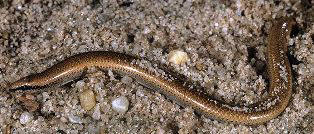 Sand
Skink
(Neoseps reynoldsi) Threatened- A unique lizard adapted to an
underground existence, the sand skink measures 4 to 5 inches in length
and has a gray to tan color. The sand skink has a wedge-shaped head, a
partially countersunk lower jaw, body grooves into which the forelegs
can be folded, and small eyes which have transparent windows in the
lower lids. These features enable the lizard to swim beneath the surface
of loose sand. The diet of this species consists of surface-dwelling
invertebrates, including beetle larvae, termites, spiders, and larval
antlions. They only occur in central Florida — 115 known sites were
recorded in 1999. However, researchers acknowledge that Sand Skinks are
difficult to detect and might be found in more places with a suitable
habitat if searched for sufficiently. Known habitat occurs in the Lake
Wales Ridge but it is also found on the Winter Haven Ridge in Polk
County and the Mount Dora Ridge. Sand
Skink
(Neoseps reynoldsi) Threatened- A unique lizard adapted to an
underground existence, the sand skink measures 4 to 5 inches in length
and has a gray to tan color. The sand skink has a wedge-shaped head, a
partially countersunk lower jaw, body grooves into which the forelegs
can be folded, and small eyes which have transparent windows in the
lower lids. These features enable the lizard to swim beneath the surface
of loose sand. The diet of this species consists of surface-dwelling
invertebrates, including beetle larvae, termites, spiders, and larval
antlions. They only occur in central Florida — 115 known sites were
recorded in 1999. However, researchers acknowledge that Sand Skinks are
difficult to detect and might be found in more places with a suitable
habitat if searched for sufficiently. Known habitat occurs in the Lake
Wales Ridge but it is also found on the Winter Haven Ridge in Polk
County and the Mount Dora Ridge.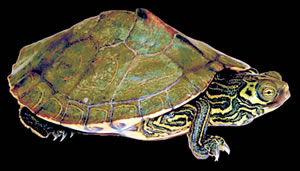 Barbours
Map Turtle
(Graptemys barbouri) SSC- Barbour's Map Turtle is found in the
Apalachicola, Chatahoochee and Chipola Rivers in Florida. This is a
medium to large size turtle. Males are about 3.5 to 5.5 inches as adults
and females are about 6 to 12.5 inches long. This turtle is part of the
broad head group of map turtles and therefore is mostly a crustacean
(mollusk) eater, but they are also opportunistic so insects and fish
could also be eaten. It has a domed shell keel that is exaggerated as a
hatchling and slowly wears down with age. This turtle lives in a large
sandy/muddy limestone rivers. Juveniles and males prefer brush piles
along the sides of the river. Females, once again, prefer deeper water
and tend to bask a little bit further out into the river. Basking tends
to be on large stems of trees instead of small branches. Barbours
Map Turtle
(Graptemys barbouri) SSC- Barbour's Map Turtle is found in the
Apalachicola, Chatahoochee and Chipola Rivers in Florida. This is a
medium to large size turtle. Males are about 3.5 to 5.5 inches as adults
and females are about 6 to 12.5 inches long. This turtle is part of the
broad head group of map turtles and therefore is mostly a crustacean
(mollusk) eater, but they are also opportunistic so insects and fish
could also be eaten. It has a domed shell keel that is exaggerated as a
hatchling and slowly wears down with age. This turtle lives in a large
sandy/muddy limestone rivers. Juveniles and males prefer brush piles
along the sides of the river. Females, once again, prefer deeper water
and tend to bask a little bit further out into the river. Basking tends
to be on large stems of trees instead of small branches.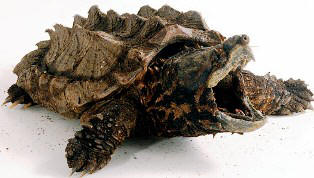 Alligator
Snapping Turtle (Macroclemys temminckii) SSC- The
prehistoric-looking alligator snapping turtle is the largest freshwater
turtle in North America and among the largest in the world. With its
spiked shell, beak-like jaws, and thick, scaled tail, this species is
often referred to as the "dinosaur of the turtle world." Found almost
exclusively in the rivers, canals, and lakes of the southeastern United
States, alligator snappers can live to be 50 to 100 years old. Males
average 26 inches in shell length and weigh about 175 pounds, although
they have been known to exceed 220 pounds . The much smaller females top
out at around 50 pounds. Alligator
Snapping Turtle (Macroclemys temminckii) SSC- The
prehistoric-looking alligator snapping turtle is the largest freshwater
turtle in North America and among the largest in the world. With its
spiked shell, beak-like jaws, and thick, scaled tail, this species is
often referred to as the "dinosaur of the turtle world." Found almost
exclusively in the rivers, canals, and lakes of the southeastern United
States, alligator snappers can live to be 50 to 100 years old. Males
average 26 inches in shell length and weigh about 175 pounds, although
they have been known to exceed 220 pounds . The much smaller females top
out at around 50 pounds.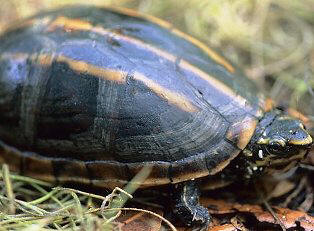 Striped
Mud Turtle
(Kinosternon baurii) Endangered- Throughout much of its range in
Florida, the striped mud turtle is characterized by yellow head stripes
and three light longitudinal stripes on a dark brown carapace. This
turtle is only 3 to 4 inches in length and has a double-hinged plastron,
similar to the eastern box turtle. The sexes can be distinguished by the
longer, thicker tails of males. The striped mud turtle is different from
most other turtles species in the Southeast in that females nest in the
fall, rather than the spring or summer. Striped mud turtles inhabit calm
freshwater habitats, such as swamps and canals with soft substrates and
are most common in cypress swamps and blackwater creeks. Striped
Mud Turtle
(Kinosternon baurii) Endangered- Throughout much of its range in
Florida, the striped mud turtle is characterized by yellow head stripes
and three light longitudinal stripes on a dark brown carapace. This
turtle is only 3 to 4 inches in length and has a double-hinged plastron,
similar to the eastern box turtle. The sexes can be distinguished by the
longer, thicker tails of males. The striped mud turtle is different from
most other turtles species in the Southeast in that females nest in the
fall, rather than the spring or summer. Striped mud turtles inhabit calm
freshwater habitats, such as swamps and canals with soft substrates and
are most common in cypress swamps and blackwater creeks.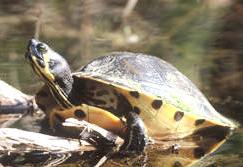 Suwannee
Cooter
(Pseudemys concinna suwanniensis) SSC- The Suwannee Cooter is
found in drainage areas of rivers that feed into the Gulf of Mexico from
Hillsborough to Gulf County. Its shell has yellow markings that appear
to be spirals at a short distance. It also has yellow stripes on its
head and front feet. It reaches a maximum length of 16". It leaves its
water habitat only to nest during the summer. The name "cooter"
comes from "kuta", the word for turtle in several African dialects.
Small invertebrates, such as worms, snails, slugs, insects, thin-shelled
bivalves and crayfishes and other crustaceans make up the bulk of the
animal food in the turtle diet. Suwannee
Cooter
(Pseudemys concinna suwanniensis) SSC- The Suwannee Cooter is
found in drainage areas of rivers that feed into the Gulf of Mexico from
Hillsborough to Gulf County. Its shell has yellow markings that appear
to be spirals at a short distance. It also has yellow stripes on its
head and front feet. It reaches a maximum length of 16". It leaves its
water habitat only to nest during the summer. The name "cooter"
comes from "kuta", the word for turtle in several African dialects.
Small invertebrates, such as worms, snails, slugs, insects, thin-shelled
bivalves and crayfishes and other crustaceans make up the bulk of the
animal food in the turtle diet.
|
|
|
Advertise | Privacy Statement | Dog Encyclopedia | Video |Contact | Alaska Nature |
|